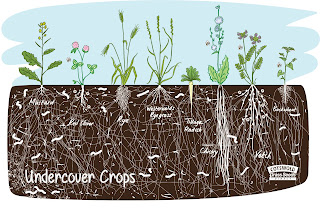What is soil?
Soil is a lot more than just dirt and mud. The dirt you get on your boots and under your finger nails is often full of life as healthy soil is home to millions of living things. Healthy soil is alive and helps plants to grow and live but if it is treated the wrong way the balance of minerals and micro organisms is lost. Soil that has been mistreated is often referred to as dead soil because it cannot support life.
What makes healthy soil?
Healthy soil is full of life for example: minerals, nutrients, bacteria, fungi and other micro organisms. Healthy soil is able to hold more water than dead soil. This is important because the plants need water and if the water ran straight through the soil the plants would die because they would not be able to collect water. The list below from Soil4Kids (http://www.soils4kids.org/about) helps explain the qualities of healthy soils
- "Soils serve as media for growth of all kinds of plants." This means soil provides and environment for the plants' roots to spread which is essential for all plant growth.
- "Soils modify the atmosphere by emitting and absorbing gases (carbon dioxide, methane, water vapor, and the like) and dust." This is talking about the exchange of nutrients between the plants and living components of the soil and the atmosphere.
- "Soils provide habitat for animals that live in the soil (such as groundhogs and mice) to organisms (such as bacteria and fungi), that account for most of the living things on Earth." This is talking about how soil is also a home for animals and life.
- "Soils absorb, hold, release, alter, and purify most of the water in terrestrial systems."
- "Soils process recycled nutrients, including carbon, so that living things can use them over and over again." This talks about the part soil has in the carbon cycle.
- "Soils serve as engineering media for construction of foundations, roadbeds, dams and buildings, and preserve or destroy artifacts of human endeavors." This refers to how soil is a natural element of manmade things.
- "Soils act as a living filter to clean water before it moves into an aquifer." This is talking about the part the soil has in cleaning the water.
Conventional farming means farming with the use of pesticides and chemical fertilisers. It does not take account of the natural balance of the soil and so this balance is often lost. Pesticides also kill insects which are needed to pollinate plants and other micro organisms. Over-farming uses up all the nutrients and doesn't restore it, the soil can't hold water anymore, the other organisms die and eventually the soil dies and nothing can grow. The dust bowl is a very good example of over-farming, because the soil just had all the nutrients sucked out which caused it to dry up and crumble creating a dust storm.
What is the alternative?
Avoiding chemical pesticides and weed killers helps to prevent damage to the soil. Organic farming involves a different approach to controlling pests that does not use chemicals, for example if you had green fly on your crops you could plant something like marigolds nearby to attract them away. Crop rotation is another important method used to keep soil healthy. For example in the first year you would grow clover and grass and allow cows to graze. By allowing the grass rot down naturally and the cows manure to rot into the ground the soil becomes extremely fertile. The following year you would plant edible crops such as carrots which need very rich soil. The next year you might plant beans or corn which need less nutrients than carrots, and finally you would plant grass and clover again and repeat the cycle. (http://mocomi.com/organic-farming/)
